This year saw the passing of O. Ivar Lovaas, PhD, Professor of Psychology at UCLA, and Stanley I. Greenspan M.D., Clinical Professor of Psychiatry and Pediatrics at George Washington University Medical School. As parents of children who received a diagnosis of autism, we reflect on the powerful influence both had on early intervention for autism.
On the face of it, the approaches they advocated were different, even contradictory. Lovaas focused on applying the principles of “behavior analysis” – especially “operant conditioning” – to the education of children with autism. Over time, he developed his own approach, the Lovaas Model of Applied Behavior Analysis. This model broke down learning into small steps, gradually building attention, teaching imitation, shaping verbal responses, to the point where he was able to teach functional language to a subset of children with autism. As his research progressed, he found that his young subjects were capable of learning more than anyone had thought possible. In 1987, he published a groundbreaking study in the Journal of Consulting and Clinical Psychology,describing the results of a controlled experiment in which roughly 47% of children treated in his program achieved “normal cognitive and intellectual functioning.”
Before and after this study, he was attracting attention, some of it negative. Many critics painted ABA – and his model in particular – as harsh. The idea of subjecting children to “operant conditioning” did not sit well with the public and did not fit in with the prevailing assumption of many experts – i.e., that autism was a form of emotional withdrawal; that what the child needed above all was the unconditional acceptance of a caring adult.
Indeed, the dominant view of autism in the 1960’s, 70’s and even 80’s, was to assume that this emotionally wounded child had “chosen” to withdraw. Bruno Bettelheim, the most famous proponent of this wounded child theory, held that the child was an “empty fortress” protecting himself from parental rejection, in need of an accepting, understanding therapist to draw him out. Even as this theory began to be debunked, and autism began to be understood as a disorder of development – most likely of genetic/neurological origins -treatments were still largely based on psychoanalysis and “play therapy,” a kind of gentle parallel play that put few demands on a child but instead tried to convey unconditional acceptance and interest in whatever the child chose to do. Virginia Axline’s hugely popular books, which continued to propagate the bad parent/savior therapist theme, established the core principles of this approach: The therapist “accepts the child for who he is;” “is alert to recognize feelings,” develops a “warm and friendly relationship with the child,” and “does not attempt to direct the child’s actions or conversations in any manner.”
Greenspan – who among his many roles was a practicing child psychoanalyst – avoided the parent bashing motif, but had similar ideas about therapy. He encouraged parents to sit beside their child and follow her lead, seeking to engage her in a non directive manner; to enter her world as much as possible rather than imposing demands upon her. His model, which he named “FloorTime: a Developmental, Individual Differences, Relationship-based Approach”, influenced thousands of parents, teachers and therapists. Over time, this model came to include an “affect based language curriculum,” a detailed methodology to help increase receptive and expressive language. Peer reviewed studies evaluating the effectiveness of FloorTime, however, are scarce.
Lovaas’ ideas too were gaining traction, mostly because evidence was mounting that ABA could indeed affect the outcome of an autism diagnosis. In 1999 the U.S. Surgeon General concluded: “Thirty years of research has demonstrated the efficacy of applied behavioral methods in reducing inappropriate behavior and in increasing communication, learning and appropriate social behavior.” There is still no medical cure for autism, but it has been amply demonstrated that most children can make significant progress under an ABA approach; a certain percentage can even achieve “normal cognitive and intellectual functioning.”
The debate between these two approaches to autism has been fierce. On one side, those who believe that Floor Time is the better way still paint ABA as consisting of rote and repetitious drills that stifle the child’s spirit. On the other side critics of FloorTime see it as a vestige of the old psychoanalytical school, lacking scientific credibility and unable to present a coherent or reproducible methodology.
As parents of children diagnosed with autism we too have had some robust debates about ABA and FloorTime, but we both understand the importance of bringing more scientific accountability to discussions of treatment. We know that ABA has the strongest evidence of effectiveness. We know that there is no inherent contradiction between an ABA approach and the notion of play. Play, singing, dancing, affection, engagement, humor – the entire panoply of loving human interaction – was an integral part of our own intervention programs and an important component of every quality ABA program we have observed throughout this land.
At the same time, we both agree that there is a pressing need for more research; other avenues of exploration; more treatment options. ABA is effective, but to varying degrees. Some children make dramatic progress; some need care for the rest of their lives. Understandably, parents have been constantly seeking to expand their treatment choices, and this leaves them vulnerable to a host of speculative therapies. At the present moment, there are over 100 “treatments” for autism offered on the Internet and in popular books – mostly by people who base their claims more on their beliefs and “clinical intuition” than on hard research data.
The challenge that we faced some years ago and that parents today face even more acutely is to sift through those 100+ therapies and attempt to wisely judge the quality of the evidence behind each of them. Parents need to be able to distinguish proven treatments; “emerging” treatments which show promise but as yet lack definitive objective validation; harmful or useless fads and miracle cures. For that urgent responsibility, there is help. The Association for Science in Autism Treatment has published research summaries for many treatments including both educational and biomedical interventions. The National Autism Center has made available a comprehensive National Standards Project establishing standards for educational and behavioral interventions.
An even greater challenge is treatment cost. ABA generally employs one-on-one tutoring in the early years. At this level of intensity, weekly bills can exceed $1,000. But the benefits to society as well as to the child may outweigh this huge price tag. We know that a significant percentage of children who have access to quality ABA programs can achieve more freedom, autonomy and independence. The cost of early intervention can be high — but that cost is perhaps a tenth as much as the lifetime expenses resulting from disability benefits and other such costs that many with autism otherwise require.
Unfortunately, fewer than half of the 50 states now require health insurance plans within their jurisdictions to cover the costs of autism therapy. Often, insurers tend to label all autism treatments “experimental.” We agree with the insurers that all treatments should be closely scrutinized, held up to scientific standards, and only promoted for the general population when they pass muster. But once they do, it is an injustice to deny children access to a treatment that can make a difference in their basic quality of life. The Obama Health Care Law may help somewhat here, but not until 2014, and not for all types of insurance programs.
There are many needs within the autism community, ranging from the search for causes to the search for more effective treatments; from the needs of children to the needs of aging adults, from the needs of people emerging from autism to the needs of people for whom autism will always be part of who they are. Dr. Greenspan and Dr. Lovaas spent their lives trying to help our children. Even if they had profound disagreements as to the best means of doing that, they clearly were both filled with compassion and concern for children. Let us take inspiration from their clarity of purpose, their sincerity of heart. It’s time to make quality treatments available and affordable to all children who need it, in all 50 states.



Commentary
Op-edAutism’s Battle Within
September 3, 2010